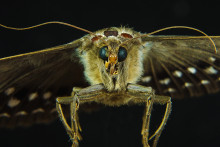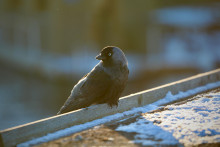To improve man-made sensors for detecting chemicals, scientists of the University of Tours (France) and the University of Twente have teamed up to study the role of insect antennas. They are especially interested in the amazing smelling performance of the night moth, which can pick up a scent more than a kilometer away.
Antenna aerodynamics are believed to contribute to an effective capture of scent molecules, adding to the moth’s keen sense of smell. However, air flows around the original antennas cannot be tested because of their fragility and complex design, involving large size differences. Therefore, the researchers designed and built simplified and bigger scale models for testing.
Huge feather-like antenna
Carefully PhD scientist Mourad Jaffar-Bandjee positions the head of a night moth into a scanning electron microscope. The machine closes and a buzzing sound indicates that a vacuum is created inside the chamber where the head is placed. After some minutes a spectacular image appears on the computer screen: an almost 3D-looking enlargement of the insect’s eye, and a huge, feather-like antenna.
This antenna is the main focus of the scientist’s study. Males use these attributes to pick-up the scent from females, sometimes more than a kilometer away. ‘This is the main antenna branch,’ says Jaffar-Bandjee, while he points at the screen. On this main branch you can clearly see the side branches, rami.’ When the scientist increases the magnification to 250 times, the image shows that each rami in turn is also covered by large amounts of tiny side branches: hair-like structures called sensillae.
'We want to understand how the aerodynamics of the antenna work'
According to Jaffar-Bandjee, even a very sensitive smell sensor cannot explain the incredible sense of smell of night moths. But possibly, the complicated antenna design contributes to the moth’s keen pheromone detection. ‘We think the antenna is crucial to capture single pheromone molecules and guide them towards the smell receptor,’ says PhD supervisor Gijs Krijnen, professor at the chair of Robotics and Mechatronics. ‘We want to understand how the aerodynamics of the antenna work and eventually build better sensors to detect chemicals by combining them with antenna-like structures based on the principles of the moth antennas.’

Capture of molecules
Technically, smell in animals consists of a sensor aimed at detecting a wide variation of compounds in different concentrations. Man-made chemical sensors are based on these principles. They are widely used in biological, medical and industrial applications, aimed at detecting certain molecules, for example for quality control of food, but also for tracking down drugs.
Most of these sensors are built with a strong focus on chemistry: sensing certain scent molecules with high sensitivity and specificity. By using the principles of the antenna design of moths and combining that with the chemical sensor, the sensitivity could be increased by a more efficient capture of molecules, the scientists believe. Therefore, Jaffar-Bandjee studies the air flow in and around the antenna to understand the role of different parts of the antenna structures in the capture of pheromones.
‘Suppose the whole flow of air goes around the antenna, the capture of scent molecules will be close to zero; the air has to go through the antenna to some extent to catch the scent,’ he explains. ‘So, to explain the moth’s keen pheromone detection, we want to know how much of the air flow goes through the antenna, how much goes around it, and how fast the air is flowing inside the antenna.’ In addition, the scientists measure the effect of the total surface area of the antenna that ‘sees’ the flow and how long the air is in contact with the different antenna structures.
Complications
However, this challenging and complex research has some substantial practical obstacles. Studying how air behaves around the antenna is easier said than done. One problem is the enormous size differences between the antenna structures. The main antenna branch is about one centimeter long, the rami on top of that branch about 1.5 millimeter, while the hair-like sensillae are only 0.1 millimeter long. ‘There are at least three different orders of magnitude where we want to study the airflow,’ Krijnen explains. ‘But we are just not able to look at these different scales at the same time, so we can’t use real antenna for our studies. In addition, it is not possible to make real-size antennas, so we have decided to build scale models that are a factor 10 to 300 bigger.’

To understand the influence of the different antenna structures on the air flow, the scientists designed several models of a bigger and simplified antenna using 3D design software. This way, they could manipulate, for example, the number, length and diameter of the branches. Printing the design using a 3D printer and testing it in the laboratory were the following steps.
One of the designs is a ten centimeters long main antenna branch, with rami, but without the tiny sensillae. Krijnen points at his computer screen where he discusses the design with Jaffar-Bandjee. ‘These simplified scale models allow us to understand the role of these antenna structures in the overall aerodynamics, especially if we vary size and number of main and side branches together with the distance between the side branches.’ In a next experiment the team will design an artificial antenna with no main branch, but with only rami and sensillae in different numbers and sizes, to understand these structures’ role in capturing the scent molecules.
High speed camera
But there are more hurdles to take. To measure air velocity around the antenna, it is necessary to use flows with reflecting particles added. A laser illuminates these particles, while a high-speed camera tracks each individual particle. In air, these particles can be hazardous and it requires a quite unpractical experimental setup. It’s safer and easier to measure particles in liquids instead.
Together with the group of Jérôme Casas, at the Institute of Research on Insect Biology Tours (France), Jaffar-Bandjee studies these fluid flows around the artificial antenna under controlled conditions. ‘We place one of our scaled antenna models into an aquarium filled with fluid and create a stream. By adding tiny, hollow glass particles and illuminating them with a laser beam, a high-speed camera system is able to register individual particles,’ he explains. ‘Then we measure the particle’s velocity before and after they reach the antenna model.’
'This knowledge could at some time help building better sensor-systems'
Based on these measurements, the scientists plan to develop mathematical models to track and describe the travel of a single pheromone molecule towards the antenna that eventually reaches the smell receptor. This knowledge could at some time help building better sensor-systems: an antenna based on the moth `design’, that guides the target molecules towards the sensor-sites, combined with the actual chemical sensors. But that’s the long-term goal. For now, Jaffar-Bandjee focuses on performing his complicated experiments and modeling his findings.







